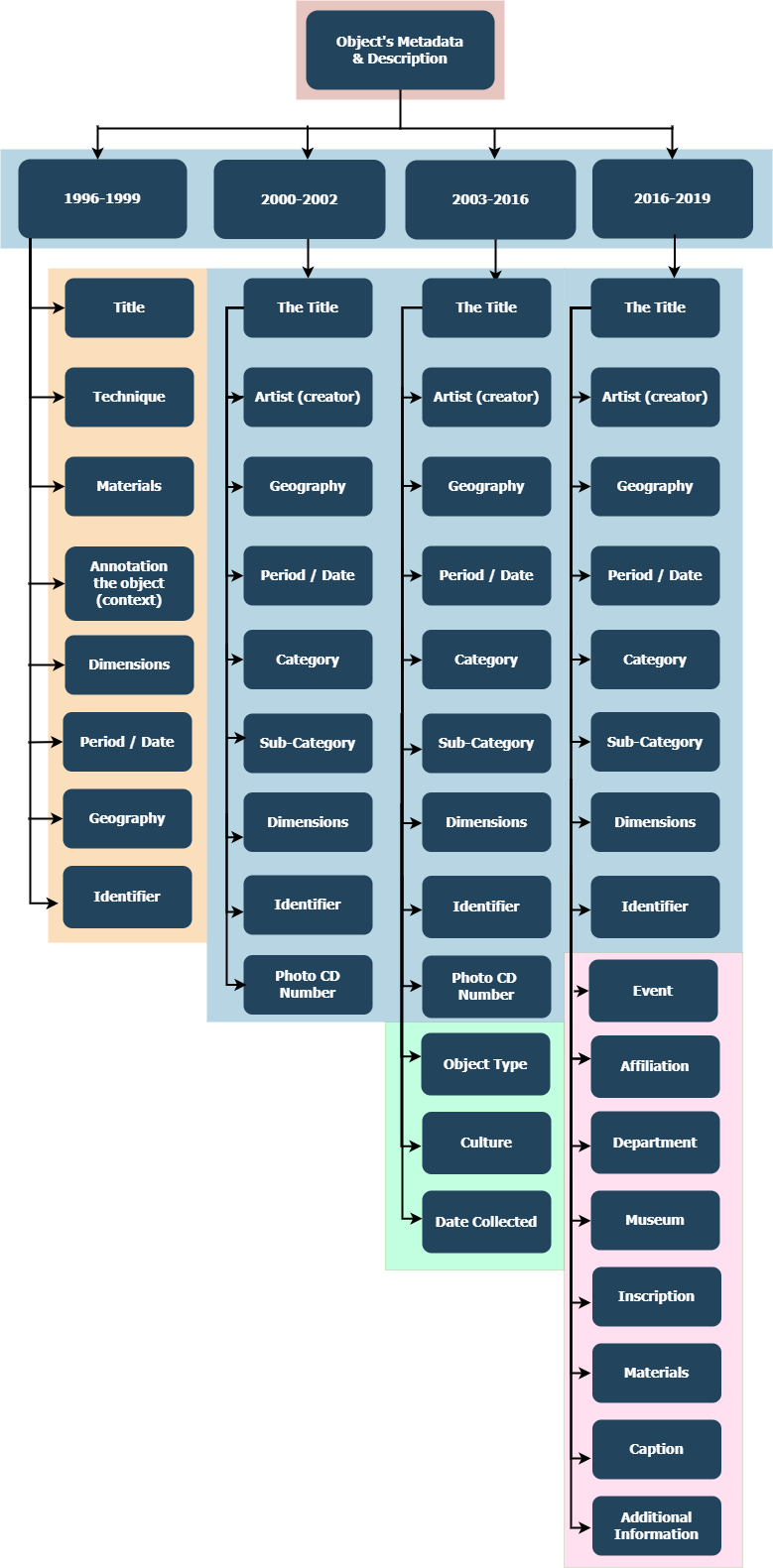The Canadian Museum of History (Quebec, Canada)
The Canadian Museum of History (Quebec, Canada) is a co-operation of three national Canadian museums: the Canadian Museum of Civilization (CMC), the Canadian War Museum (CWM), and the Virtual Museum of New France (VMNF). The museum was founded in 1856 and changed its name several times. Until 2013, when the museum took its current title, it was known as the Canadian Museum of Civilization Corporation (1986-2013). The case of the Canadian Museum of History is important to be considered as a one of the first examples of museum associations online. Also interesting is the Museum Corporation’s approach to presenting museum space online and the metaphorical nature of the first version of a virtual corporate museum.
Virtual Museum as a Metaphor of a Real Museum in Virtual Environment
In 1996, when the virtual museum was created, The Canadian Museum of History was the Canadian Museum of Civilization Corporation and consisted of several museums. The Corporation’s approach to creating a virtual museum is an example of a metaphorical idea of transferring the museum’s metaphor as a well-structured architectural construction with floors dedicated to separate themes or eras and halls that are reveal the themes in details. At the subtopic level, the museum metaphor gives way to a new format for representation of information in the form of a digital collection of exhibits in online environment, which are accompanied by a text narrative.
In early 2000s the web-site was modernized and evolved to suit the virtual environment. The visibility of a variety of digital initiatives has been significantly increased. The main pages show that digital activities became a dominant purpose for the web-site development at that time. At present, the main page demonstrates the dominance of on-spot events rather than digital activities and online exhibitions.





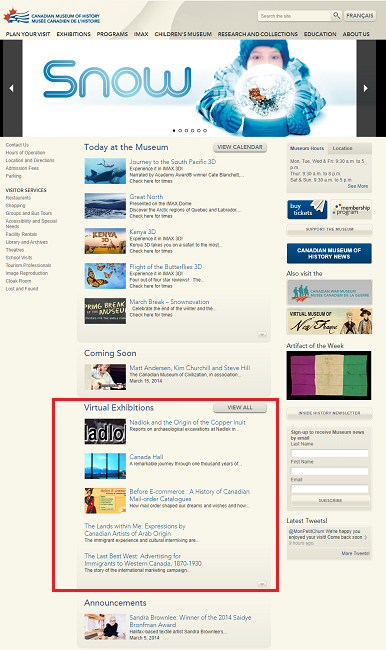

Digital Exhibitions. Digital Museum Storytelling
The forms of information representation about the museum collections and the disclosure of different topics are varied. Storytelling in the virtual museum is the main form of knowledge transfer and narration about individual topics illustrated with images of objects. The concept of a virtual museum is directly linked to the online narrative rather than to an invitation to visit the museum through the exposition of the best examples of objects from the museum’s collections.
Some topics have corresponded to the permanent exhibitions held at the museum and described the circumstances of the obtaining of the exhibited collection with hyperlinks to related topics such as personalities, regions, historical periods, information about the curators of the exhibition and links to recommended literature. The museum actively uses hypertext in the description of collections and exhibitions, linking different pages of the online resource for a deeper immersion of the visitor in the topic.
Digital resources describing ongoing exhibitions have been created especially carefully for external exhibitions. Such resources contain deep historical contexts with various references to historical events, names of famous people, geographical places and were illustrated with images of objects from the exhibition. Digital exhibitions were built on the basis of revealing a specific topic using a narrative and reinforcing it with various materials such as slide shows with photographs of objects or memorials, video films, examples of objects from museum collections. At the same time, exhibitions are supplemented by bibliographic information, as well as links to related resources on the Internet. These digital resources about the exhibitions have been created in advance in order to give visitors to the site the opportunity to get acquainted with the topic and unleash the potential of the upcoming exhibition. It should be noted that the quality of the content resources made it possible to use this digital resource independently as educational material without a mandatory visit to the museum, which significantly increased the value of the virtual museum. In early 2000s the main categories of topics were organized into a special section in the left sidebar, so that the visitor could explore the digital resources by topics or use the newly introduced search tools.
Online Exhibitions have developed to become more complex in terms of structure and interconnectedness of the elements. By 2010, online exhibitions had significantly changed their structure and were accompanied by a whole range of materials and storytelling in various formats, including text, audio and video.
The representation of objects in the search database and visualization on the pages of online exhibitions differed from each other, both in the completeness of the data presented and in design. On the pages of online exhibitions, in addition to the meta description and the image of the object, extended information about the object, the collector, fragments from the oral history stories, related topics of the exhibitions and timelines were added. The Timelines were introduced for the navigation across the exhibition rather than across collections.












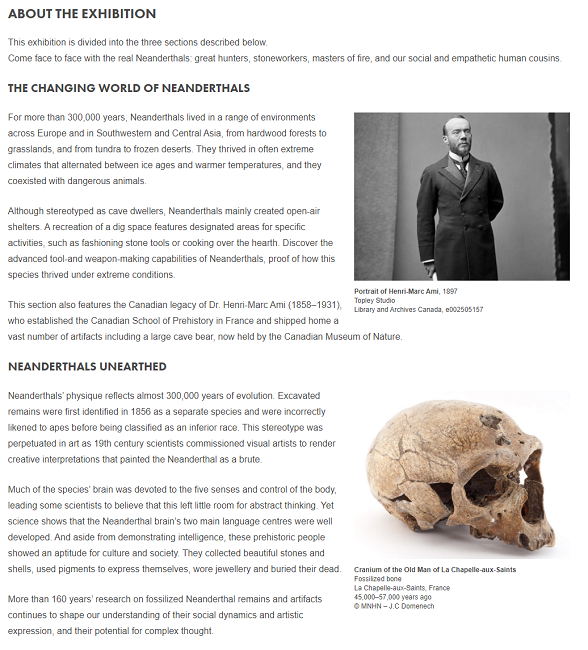
Digital Objects. Digital Collections
Pages with objects’ descriptions and small illustrations were created from the very beginning of the existence of the web-resource. Sometimes images of objects without any textual description were part of the museum storytelling. However, some of the exhibitions contained descriptions of objects with data on the performance technique, materials and sizes of the objects. Initially, the meta-description of objects was not standardized and was very different between objects. In most cases, the description was limited to textual annotation, although other objects could contain information about location, time of creation and identification.
Along with storytelling, other topics contained descriptions of collections and their provenance with examples of iconic objects from collections. Thus, in 1990s there was no unified approach to the description of collections in the online environment, but different options were tested. Since 2000, the “Collection Storage” section has appeared in the virtual museum. Digital collections with exhibits were exposed in a more organized manner. Two possibilities of exploration the digital collections were implemented. One of them is a search by keywords, and the other is “Browse the Aisles” looking for the objects divided into the thematic categories. This structure of the search system remained until 2009, when the museum changed the search somewhat, highlighting the search for several main thematic categories, significantly reducing their number.
With the introduction of the museum collections objects database “Collection Storage” in 2000, a more precise meta-description for objects was imposed, which included a set of linked data, such as Object Name, Culture, Geographical Origin, Date Collected, Category, Sub-Category, Dimensions, and Catalog Number. However, the textual annotation has been removed from the object description.
During 2000-2016 changes in the objects’ presentation were minor and associated mainly with a slight extension of the metadata provided. In 2016 the collection database was modified and the structure of exposed data including the description of the object was renewed. Various images of the single object began to be attached, including enlarged details, which improved visualization.





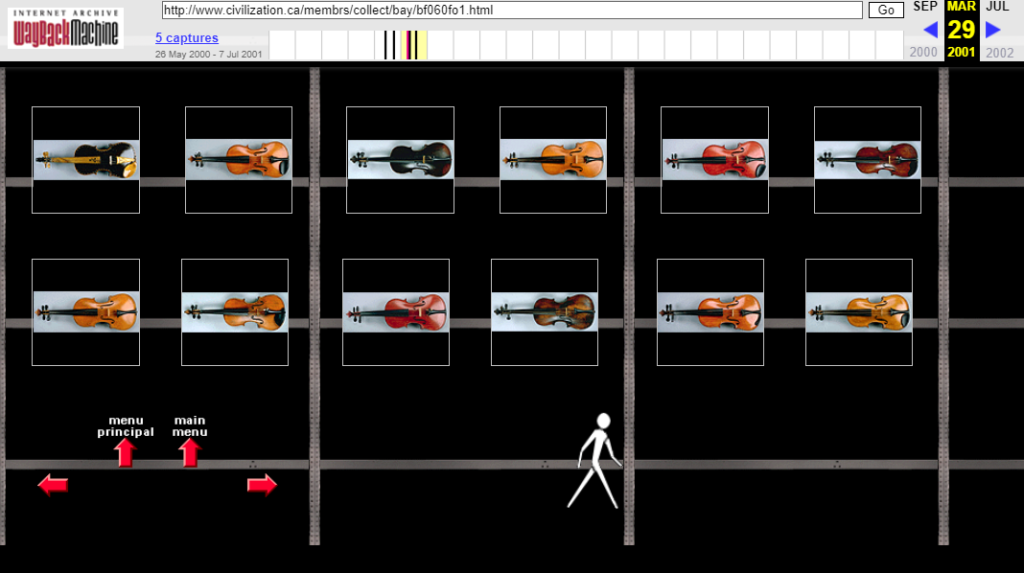



The dynamics of the publication of digitized objects on the site is reflected in the diagram below. The number of objects represented in the database for 2004-2015 is based on a description of the resource, but not actual quantitative indicators on statistics. Real statistics for 2016 – 2019 reflect the actual amount of objects represented in the database. A significant decrease in the number of objects in 2018 reflects the transit period to images of a higher quality that meet new standards and the massive approach to digitizing and publishing digital copies of cultural heritage objects from the Museum’s collections.
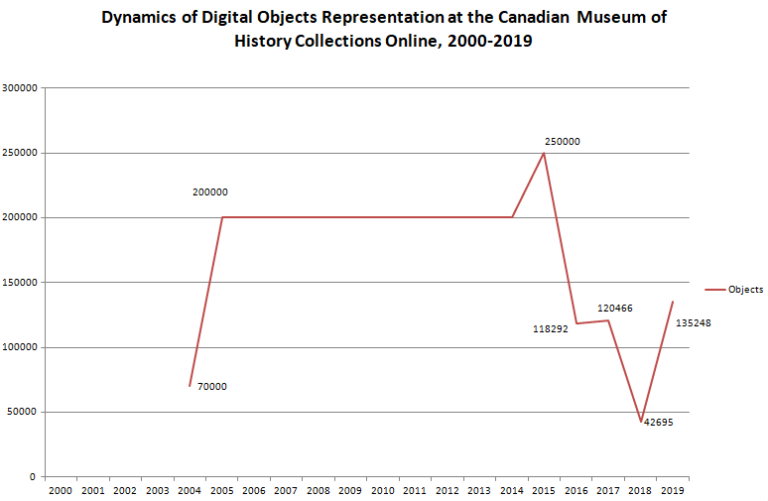
Engagement with Audiences Online. Education. Research
From the very beginning the exhibitions of the virtual museum had a high educational potential, since they contained not only information about objects, but also the various topics revealed in a wider historical context. The Teacher’s Guides were created which offered a variety of ideas for their implementation by educators in the classrooms. The museum created educational resources with a broader theme and wider context, and did not always illustrate the created content using objects from the museum’s collections but prepared the topics on the themes of upcoming exhibitions at the museum. For example the resource “Mysteries of Egypt” presented diverse stories related to the history of Egypt and was illustrated with photographs of monuments and sights of Egypt (some photos were published without attribution and the origin of the photographs, while other photographs were referred to other museums). That means that the Canadian Museum of History tended to expose the storytelling rather than the exhibition with objects in a narrow sense.
In 1999-2000 the Museum introduced the CyberMentor interactive service which was developed for use in education and to boost the cooperation between educational institutions (mainly with schools) and the Museum. The service was intended to introduce the theme of hats and puppets to the virtual visitors and to be used in classes with an interaction online and included variety of materials and recommendations to teachers to be used in classes.
The early 2000s became a significant period for the web-source development due to the new approaches to the audiences online. The Museum has defined the main categories of the audiences such as Kids, Educators, Scholars and Media for whom the Museum produces digital content. The interface for Kids category has been transformed into a user-oriented way. The every category of users received the targeted digital resources which were regularly filled during the next years.
The Research opportunities were introduced in early 2000s and were quickly widened to a variety of useful digital instruments such as museum’s publications access, digital libraries and archives catalogs, online tools and services for researchers and many other initiatives for the studies and research.
After 2014, the focus on specific audiences with the development of virtual space is dispersed, since different audiences can have common interests on the website and look for the same information. A generic Learn at the main page instead of “Research and Collections” and “Education” section appears which includes a variety of sections on Research and Education.








Summary
Thus, The Museums’ Corporation was able to create such a virtual museum, which brought together in a virtual space the diverse resources of the associated museums. Moreover, the uniqueness of each museum has not been lost in digital space. Various opportunities were implemented for users, which allowed virtual visitors to study both museums separately and together. The history of the development of the web resource shows that initially and until 2014, digital initiatives dominated the use of a virtual resource as an advertisement for a real museum with an invitation to visit it. Many of the digital resources that are currently maintained were developed before 2014. After this date, the museum changed its attitude towards digital space and the visibility of digital features decreases significantly. A feature of this virtual museum is a high degree of linkages of digital features and the current exhibition activities of a real museum. From the mid-1990s until the reform of the museum in 2014 this interpenetration was significant, which created complex digital exhibitions with the presentation of multilayer material. At present this linkage is much evident and with fewer details. Today, the additional information about the exhibition can only encourage the interest of a potential visitor to visit a real museum space and give basic ideas on the topic, and does not provide new significant information online.
